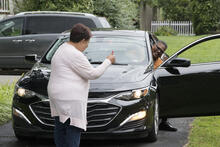Traffic Safety: Older Drivers
We all want to stay healthy, mobile, and independent, but over time, our bodies change in important ways that may impact our ability to drive safely. Changes in vision, for example, can make driving in certain conditions difficult. Changes to mobility, reflexes, and general fitness can reduce reaction times. As an older driver, it is important to learn about your needs and have conversations with family or your doctor before challenges arise.
Older drivers in Wisconsin
The U.S. population is aging, and older people now makeup a larger proportion of the population. Many older Americans are living and staying active longer. As a result, older drivers are keeping their licenses longer. Unfortunately, older drivers in Wisconsin experience a higher rate of motor vehicle death than younger drivers.
Wisconsin data from Wisconsin 2019-2023 show:
- 150 Wisconsin residents over 65 died due to a motor vehicle accident in 2023.
- Motor vehicle accidents are the second leading cause of injury death in people over 65 in Wisconsin.
- People over 65 are more likely to die due to an accident involving a motor vehicle. The rate of fatal motor vehicle deaths among people over 65 (13.5 per 100,000 people) is significantly greater than among younger drivers.
Source: Wisconsin Department of Health Services, Division of Public Health, Office of Health Informatics. Wisconsin Vital Records Data. Wisconsin Hospital Discharge Data. Pulled 01/27/25.
As we age, changes that are part of the normal aging process can affect driving ability. For example, hearing, muscle tone, reaction time, and vision (especially vision at night) all decline with age. Additionally, increased medication to control or treat health conditions can come with unwanted side effects, like sleepiness.
Decisions about someone’s ability to drive should never be based on age alone. However, physical changes and medication use may raise concern for you or your family. Be sure to consult your doctor if you or your loved ones are concerned about driving safely.
Driver behavior also changes in positive ways as we age
- Decreased impaired driving: Older drivers are less likely than younger drivers to be involved in alcohol-related crashes.
- Limit setting: Older drivers recognize their limits and avoid driving in places or conditions that they feel uncomfortable, such as at night, on high-speed roads, or on unfamiliar routes.
- Seat belt use: Older adults are more likely to report seat belt use than young adults. Seat belt use among drivers aged 70 and older is slightly higher than the national average.
What can you do
- Make sure you understand how medical conditions and medications can affect your ability to drive safely.
- Plan your route to avoid high traffic, high speed, or unfamiliar roads.
- Reduce distractions while driving.
- Get an annual eye exam to check for vision changes. Anti-reflective coating on eye glass lenses may help reduce glare at night.
- Clean your windshield and check your cars headlights. If they are dim, foggy, or burnt out your view of the road will be limited.
- If driving at night is challenging, plan your schedule to be home before the sun goes down.
- When out after dark, be sure your headlights are on, slow down, and keep an eye out for all road users.
References
- U.S. Department of Transportation
- National Highway Traffic Safety Administration
- CDC (Centers for Disease Control and Prevention)
Questions
If you have questions about data presented on this page, email the Wisconsin Department of Health Services, Division of Public Health Data Resource Center at DHSDPHDataResourceCenter@dhs.wisconsin.gov.



